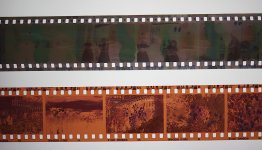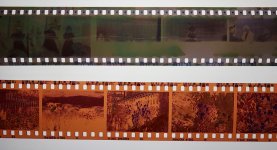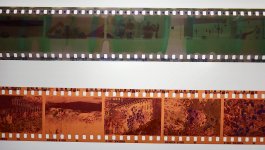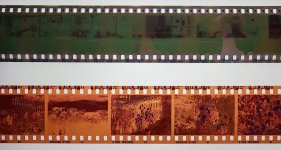- Messages
- 332
- Name
- James
- Edit My Images
- Yes
Help! I developed a roll of SupaSnaps 100ASA Colour Print Film today that was in a recent Ebay purchase of a Kiev 4AM camera. I think the camera may also be having issues as in some of the images the bottom half does not appear the have been exposed; the Kiev focal plane shutter travels vertically so I'm wondering if it's capping.
The chemicals used were from a Rollei Compard Digibase kit which was purchased March 2022 but only opened and mixed up last Sunday when I developed 2 36 exposure films and a 24 exposure film that was in another Ebay purchase. These films seemed to develop OK, the pictures below include a strip from one of these films for comparison which seems rather orange but scanned OK on a Nikon CoolScan IV. Some scans from the film in the other Ebay purchase (Kodak Max 400) are in the 'Found film' thread.
In my (limited) experience the Digibase chemicals are long lasting and if they had deteriorated significantly since last Sunday I would have expected the effect to be more uniform, the markings below suggest surge marks to me although the green tint is also odd.
I don't think I did anything different from my usual process using a Paterson System 4 tank:
I'm wondering, however, whether I took too long in pouring in the developer and starting to agitate giving the markings visible on the film. The spiral appeared to load freely with no issues so I would be surprised if the film had come into contact with itself causing the markings.
In the first four pictures below the (orange) comparison negatives from one of the films developed last week is the same strip, only the images from today's effort differ.
All comments and suggestions gratefully received.




And, for what it's worth, a close up of one image.
The chemicals used were from a Rollei Compard Digibase kit which was purchased March 2022 but only opened and mixed up last Sunday when I developed 2 36 exposure films and a 24 exposure film that was in another Ebay purchase. These films seemed to develop OK, the pictures below include a strip from one of these films for comparison which seems rather orange but scanned OK on a Nikon CoolScan IV. Some scans from the film in the other Ebay purchase (Kodak Max 400) are in the 'Found film' thread.
In my (limited) experience the Digibase chemicals are long lasting and if they had deteriorated significantly since last Sunday I would have expected the effect to be more uniform, the markings below suggest surge marks to me although the green tint is also odd.
I don't think I did anything different from my usual process using a Paterson System 4 tank:
- 3 minute presoak with water at 38°C, cap on, inversion agitation for first 15 secs then once or twice every 30 secs then empty
- 3 min 15 sec developer at 38°C, cap on, inversion agitation for first 15 secs then once or twice every 30 secs then empty
- 6 min 30 sec bleach at <38°C (whatever temp water bath has reduced to) cap on, inversion agitation for first 15 secs then once or twice every 30 secs then empty
- 'Levenson' wash - fill with water, 5 inversions, leave for 5 mins then empty, refill, 10 inversions, leave for 5 mins then empty, refill, 20 inversions, leave for 5 minutes then empty
- 6 min 30 sec fixer at <38°C (whatever temp water bath has reduced to) cap on, inversion agitation every 30 secs
- 'Levenson' wash as above but with a extra stage with 40 inversions for good measure
- 1 min 30 sec stabiliser bath
I'm wondering, however, whether I took too long in pouring in the developer and starting to agitate giving the markings visible on the film. The spiral appeared to load freely with no issues so I would be surprised if the film had come into contact with itself causing the markings.
In the first four pictures below the (orange) comparison negatives from one of the films developed last week is the same strip, only the images from today's effort differ.
All comments and suggestions gratefully received.




And, for what it's worth, a close up of one image.





